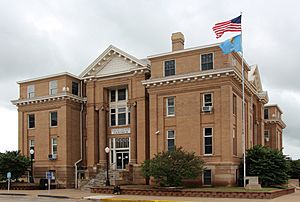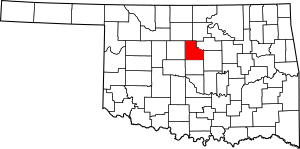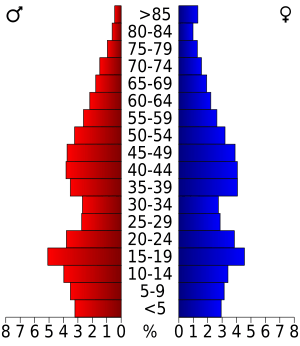Logan County, Oklahoma facts for kids
Quick facts for kids
Logan County
|
|
|---|---|

Logan County Courthouse, Guthrie, Oklahoma
|
|

Location within the U.S. state of Oklahoma
|
|
 Oklahoma's location within the U.S. |
|
| Country | |
| State | |
| Founded | 1890 |
| Named for | John A. Logan |
| Seat | Guthrie |
| Largest city | Guthrie |
| Area | |
| • Total | 749 sq mi (1,940 km2) |
| • Land | 744 sq mi (1,930 km2) |
| • Water | 5.0 sq mi (13 km2) 0.7%% |
| Population
(2020)
|
|
| • Total | 49,555 |
| • Density | 66.16/sq mi (25.545/km2) |
| Time zone | UTC−6 (Central) |
| • Summer (DST) | UTC−5 (CDT) |
| Congressional district | 3rd |
Logan County is a county located in the U.S. state of Oklahoma. In 2020, about 49,555 people lived there. Its main city and government center is Guthrie.
Logan County is part of the larger Oklahoma City area. Guthrie was once very important. It served as the capital of Oklahoma Territory from 1890 to 1907. Then, it was the state capital of Oklahoma from 1907 to 1910.
Contents
History of Logan County
After the Oklahoma Organic Act of 1890, Oklahoma Territory was created. Logan County was one of the first six counties formed from the "Unassigned Lands." The town of Guthrie was chosen as the county seat and the capital of the new territory. The county was named on August 5, 1890, after John A. Logan, a U.S. Senator from Illinois.
Early Settlements and Land Runs
Before 1889, the land that became Logan County was home to the Creek and Seminole tribes. They had moved there in the 1820s and 1830s. This happened after the U.S. government forced them from their original homes.
During the American Civil War, these tribes supported the Confederacy. After the war, in 1866, the U.S. government made new treaties with them. These treaties reduced the tribes' lands. Some areas were set aside as "Unassigned Lands."
In 1889, a law was passed to open these lands for settlement by non-Native people. This led to the famous "land run" on April 22, 1889. People rushed to claim land for farms and homes.
County Growth and Development
In 1891, three more areas were added to Logan County. These came from parts of the Sac and Fox lands. This happened after these lands were divided up among individual tribal members. Any land left over was sold to non-Native settlers.
In the same year, Cora Victoria Diehl made history. She won the election for county register of deeds. This made her the first woman ever elected in Oklahoma Territory.
Before 1889, the Kansas Southern Railway built a train line through the area. This line connected Kansas to Purcell in Indian Territory. Stations were built in what is now Logan County, like Beaver Creek (now Mulhall, Oklahoma) and Deer Creek (now Guthrie). After the land run, Guthrie grew into a busy trade center. Railroads helped connect it to other markets.
More railroads were built over time. The Denver, Enid and Gulf Railroad connected Guthrie to Enid, Oklahoma. The Choctaw, Oklahoma and Western Railroad ran between Guthrie and Chandler, Oklahoma. The Missouri, Kansas and Texas Railroad went east from Guthrie to Fallis, Oklahoma. From 1916 to 1944, an electric train line, called an interurban, ran between Guthrie and Oklahoma City.
Geography
Logan County covers about 749 square miles. Most of this is land, about 744 square miles. Only a small part, about 5 square miles, is water. The county is located in an area called the Red Bed Plains. The Cimarron River flows through it. Smaller streams like Cottonwood Creek and Ephraim Creek also drain the land.
Major Highways
 Interstate 35
Interstate 35 U.S. Highway 77
U.S. Highway 77 State Highway 33
State Highway 33 State Highway 51
State Highway 51 State Highway 74
State Highway 74 State Highway 74C
State Highway 74C State Highway 105
State Highway 105
Neighboring Counties
- Garfield County (north)
- Noble County (north)
- Payne County (northeast)
- Lincoln County (east)
- Oklahoma County (south)
- Kingfisher County (west)
Population Information
| Historical population | |||
|---|---|---|---|
| Census | Pop. | %± | |
| 1900 | 26,563 | — | |
| 1910 | 31,740 | 19.5% | |
| 1920 | 27,550 | −13.2% | |
| 1930 | 27,761 | 0.8% | |
| 1940 | 25,245 | −9.1% | |
| 1950 | 22,170 | −12.2% | |
| 1960 | 18,662 | −15.8% | |
| 1970 | 19,645 | 5.3% | |
| 1980 | 26,881 | 36.8% | |
| 1990 | 29,011 | 7.9% | |
| 2000 | 33,924 | 16.9% | |
| 2010 | 41,848 | 23.4% | |
| 2020 | 49,555 | 18.4% | |
| 2023 (est.) | 53,029 | 26.7% | |
| U.S. Decennial Census 1790-1960 1900-1990 1990-2000 2010 |
|||
In 2000, there were 33,924 people living in Logan County. The population density was about 46 people per square mile. By 2020, the population had grown to 49,555. In 2022, it was estimated to be around 51,933 people.
About 25.5% of the population was under 18 years old in 2000. The median age was 36 years. This means half the people were younger than 36 and half were older.
Communities
Logan County has several cities and towns.
Cities
- Cedar Valley
- Crescent
- Guthrie (This is the county seat, where the main government offices are.)
Towns
Census-Designated Places
These are special areas that are like towns but not officially incorporated.
- Crescent Springs
- Lovell
- Seward
- Twin Lakes
Unincorporated Communities
These are small settlements that are not officially part of a city or town.
- Four Counties Corner (This place used to be called Lockridge.)
Notable People
- Edward P. McCabe
- James Masterson: In the early 1890s, this famous lawman worked as a Deputy Sheriff for Logan County.
- Angie Debo (1890 - 1988): A well-known historian.
Historic Places
Many places in Logan County are listed on the National Register of Historic Places. This means they are important historical sites.
- Carnegie Library, Guthrie
- Co-Operative Publishing Company Building, Guthrie
- Angie Debo House, Marshall
- Guthrie Armory, Guthrie
- Guthrie Historic District, Guthrie
- Langston University Cottage Row Historic District, Langston
- Logan County Courthouse, Guthrie
- Methodist Church of Marshall, Marshall
- Morris House, Langston
- Mulhall United Methodist Church, Mulhall
- Oklahoma State Bank Building, Mulhall
- Scottish Rite Temple, Guthrie
- St. Joseph Convent and Academy, Guthrie
Media
- The local newspaper is the Guthrie News-Leader. It has been serving Logan County since 1892.
See also
 In Spanish: Condado de Logan (Oklahoma) para niños
In Spanish: Condado de Logan (Oklahoma) para niños


